|
|
 |
|
Calanoida ( Order ) |
|
|
|
Diaptomoidea ( Superfamily ) |
|
|
|
Candaciidae ( Family ) |
|
|
|
Candacia ( Genus ) |
|
|
| |
Candacia magna Sewell, 1932 (F,M) | |
| | | | | | | Ref.: | | | Sewell, 1932 (p.338, figs.F,M); Grice, 1963 (p.177, figs.F,M, Rem.); Vervoort, 1965 (p.164, figs.F,M, Rem.); Silas, 1972 (p.649); Bradford-Grieve & al., 1999 (p.885, 956, figs.F,M) | 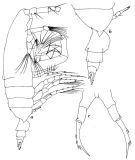 Issued from : W. Vervoort in Atlantide Report, 1965, 8. [p.165, Fig.25] Female (from Angola-Sierra Leone): a, habitus (lateral right side); b, posterior part cephalothorax and urosome (lateral right side); c, P5. Nota: Proportional lengths of prosome and urosome as 45:11. Head and 1st thoracic segment partly fused (line visible on the dorsal surface), 4th and 5th completely fused. A distinct hump in the middorsal line at the end of the head. Rostrum composed of weally bilobated chitinized structure (completely hidden between the basal parts of A1).
|
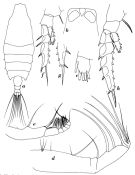 Issued from : W. Vervoort in Atlantide Report, 1965, 8. [p.166, Fig.26] Female: a, habitus (dorsal); b, forehead (ventral, after removal of A1); c, left caudal ramus (dorsal); d, Mx2; e, Mxp; f, left P1; g, 3rd exopodal segment of right P5; h, P2. Nota: Urosome 3-segmented, the urosomal segments and furca in the proportional lengths 44:21:15:20 = 100. Each caudal ramus with a distinct but small spine. Genital segment symmetrical in dorsal view. A2, Md and Mx1 are as in C. maxima. Mx2 differs from that of C. maxima by the development and place of insertion of the spiniform setae; the praecoxa has 3 groups of setae; the coxa (imperfectly separated from praecoxa), with 1 spiniform, curved seta; basis with 2 very strong spiniform setae, a similar seta occurs on the weakly developed 4th segment; endopodite indistinctly 2-segmented, with 2 strong spiniform seta, plus 3 fine setae and 1 seta of intermediate length; thera are no endites, the setae insert directly on the segments (so that it is difficult to homologize the various segments of this appendage with that of a normally shaped maxilla.
|
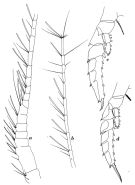 Issued from : W. Vervoort in Atlantide Report, 1965, 8. [p.168, Fig.27] Female: a-b, A1; c, P3; d, P4. Nota: A1 24-segmented (segments 24 and 25 fused) reaching beyond the furca by the last 3 segments
|
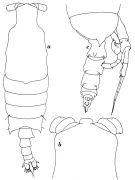 Issued from : W. Vervoort in Atlantide Report, 1965, 8. [p.169, Fig.28] Male: a, habitus (dorsal); b, forehead; c, postrior part cephalothorax and urosome (lateral right side). Nota: Head and 1st thoracic segment almost completely separate, 4th and 5th separated. Urosome 5-segmented, the urosomal segments and furca in the proportional lengths 22:23:18:13:7:17 =100. Genital segment with a rounded protusion on the right side.
|
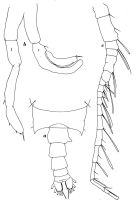 Issued from : W. Vervoort in Atlantide Report, 1965, 8. [p.171, Fig.29] Male: a, postrior part cephalothorax and urosome (dorsal); b, P5 (l = left leg; r = right leg); c, right A1. Nota: Coxae of left and right leg fused in the proximal portion; right basis curved with a hair at the beginning of the external margin; exopodite 1-segmented articulates with the proximal portion of the basis to form a chela, it has an internal carina and 2 apical spinules; the left leg 4-segmented (coxa, basis and 2 exopodal segments).
|
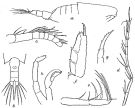 Issued from : R.B.S. Sewell in Mem. Indian Mus., 1932, X (continued). [p.339, Fig.111]. Female (from off SE Sri Lanka): a, habitus (lateral right side); b, last thoracic segment and urosome; c, A1 (proximal segments); e, Mx2; f, terminal segment of endopod of P3; g, P5. Male: d, distal segments of the grasping A1; h, P5.
|
 Issued from : W. Vervoort in Atlantide Report, 1965, 8. [p.167] Female & Male: Setal (arabic numerals) and spinal (Roman numerals) formula of the swimming legs P1 to P4.
|
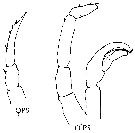 Issued from : J.M. Bradford-Grieve, E.L. Markhaseva, C.E.F. Rocha & B. Abiahy in South Atlantic Zooplankton, edit. D. Boltovskoy. 1999, Vol. 2, Copepoda; [p.1065, Fig. 7.369: Candacia magna ].
| | | | | Compl. Ref.: | | | Wiebe al., 1988 (p.985, tab.7); Osore & al., 2004 (p.195) | | | | NZ: | 3 | | |
|
Distribution map of Candacia magna by geographical zones
|
| | | | | |  Chart of 1996 Chart of 1996 | |
| | | | Loc: | | | G. of Guinea, N Indian (off SE & W Sri Lanka), Kenya: Mombassa (in Okemwa & Revis, 1986), NE Pacif. (G. of California: Guaymas Basin, in Wiebe & al., 1988) | | | | N: | 5 (Atlant. S: 1; Indien: 3, Pacif.1) | | | | Lg.: | | | (16) F: 4,48-4,4; M: 4,36-3,9; (44) F: 4,16; M: 3,7; {F: 4,16-4,48; M: 3,70-4,36} | | | | Rem.: | Lagoon.
The distribution pattern of this species is surprising.
After Grice (1963, p.177) Sewell (1948) indicated that this species is identical to C. falcifera Farran, they differ in a number of ways and the species are considered distinct.
For Vervoort (1965, p.164) the general shape of the body greatly resembles the condition observed in C. falcifera Farran (1929), C. parafalcifera Brodsky (1950), and C. maxima Vervoort (1957), with which species the present form is closely related. | | | Last update : 22/01/2016 | |
|
|
 Any use of this site for a publication will be mentioned with the following reference : Any use of this site for a publication will be mentioned with the following reference :
Razouls C., Desreumaux N., Kouwenberg J. and de Bovée F., 2005-2025. - Biodiversity of Marine Planktonic Copepods (morphology, geographical distribution and biological data). Sorbonne University, CNRS. Available at http://copepodes.obs-banyuls.fr/en [Accessed January 05, 2026] © copyright 2005-2025 Sorbonne University, CNRS
|
|
 |
 |










